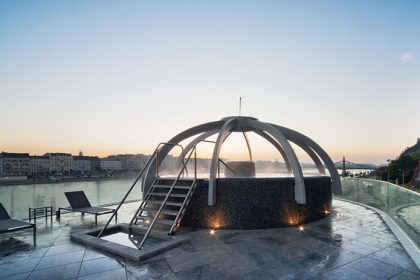

CONTACT US
1052 Budapest, Jane Haining Quay, Dock 11.
Customer support is available daily from 9:00 to 22:00.
Budapest, Jane Haining Quay, Dokk 11, 1052

If you like spending your time in baths, the Hungarian capital city is a Paradise for you, since it is called the “City of baths”! Here you can find 11 baths and 6 of them are thermal baths. Gellért, Széchenyi, Lukács, Rudas, Király, and Dandár Baths are thermal baths and they also have wellness pools. Among them, Széchenyi, Lukács and Gellért Thermal Baths are representative historic buildings in Budapest.

Near the Rudas Thermal Bath, there are 21 heat springs. Among them, Hygieia and Diana support the pools while other ones’ water can be tasted in the drinking hall. Attila heat spring has sulfurous water, the rate of hydrogen-carbonate is high in Hungaria’s water and Juventus’ water contains much radium. In the early 20th century, Gyula Weszelszky performed the analysis of the water. The water of the pools contains sodium, calcium/magnesium/hydrogen-carbonate, sulfate, and fluoride ions. It is recommended for musculoskeletal diseases such as acute or subacute arthritis, degenerative diseases, spinal disc herniation, neuralgia, and osteoporosis.
You can find the hottest thermal pool of Budapest in Rudas Bath, in the section called steambath. Its water is 42°C. Steam has several beneficial effects on your body. It stimulates blood circulation, makes muscles relaxed, and it also reduces the catarrh of the mucous membrane of the airways. In the steam, pores of the skin dilate and so they become cleaner.
Its first mention in a written source is from 1292. From the age of the Anjou Kings (the first part of the 14th century), there are detailed travelogues, and they say that this thermal bath is famous even in far countries. Before the Turkish invasion, it was the property of the archbishop of Kalocsa. The Turkish are really interested in the culture of baths so they renovated, rebuilt, and happily used Rudas bath, too. A famous historiographer, Evila Cselebi gave a detailed description of it. He wrote that the space under the cupola is so huge that “it can hold even one thousand Muslim soldiers.”
After the expulsion of the Turkish, Lipót I King presented the bath to the city of Buda. If this date is considered as the foundation we can say that Rudas Bath is the oldest public institution of the whole country with its 300-yeared age. In later centuries of the Hungarian history, it became the center of the elite social life. For example, guests could enjoy the performance of an orchestra! In the first part of the 19th century, a hotel was built to the bath which had 15 rooms, a huge dining room, and even a billiard room (this latter one only for men). This was built in a beautiful Classicists style but unfortunately, it was destroyed in 1944, during the assault of Budapest in the 2nd World War.

During the 19th century, the building of the bath was rebuilt in multiple times. Among others, Miklós Ybl worked on it who was a famous Hungarian architect (he designed the Hungarian State Opera House or the St. Stephen’s Basilica, too). It is an interesting fact that the bath had the most visitors during the 1st World War. There were so many guests that leaders of the institution considered even night opening hours. During the 2nd World War, most parts of the bath were seriously damaged but after the war, it was renovated in multiple phases. In 1954, a hospital department was also created with 28 beds. The last renovation was in 2012 when the reception hall and the frontage were rebuilt.
There are also some frightening items in its history. First of all, some conspirators after a rebellion led by Martinovics in the 18th century committed suicide here. In the 19th century, unfortunately, further people ended their lives in Rudas Bath in a similar way.
Have you thought that Rudas Budapest Thermal Bath is a film star? Actually, it is! Fans of the popular costume TV-series titled ‘Borgias’ may remember the Neapolitan bath scene from the 9th part of the 1st season which was shot in this Budapest bath. Moreover, the first scene from Red Heat (a film starring with Schwarzenegger) was also shot here.